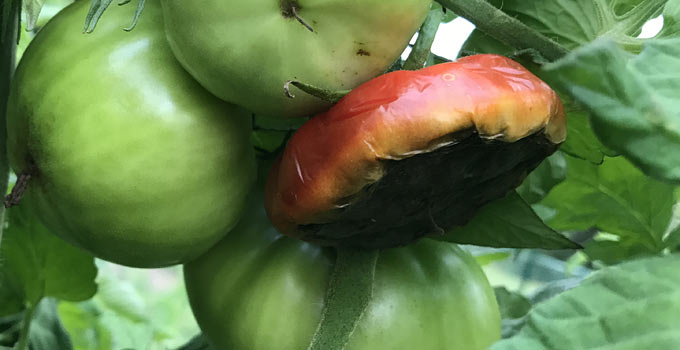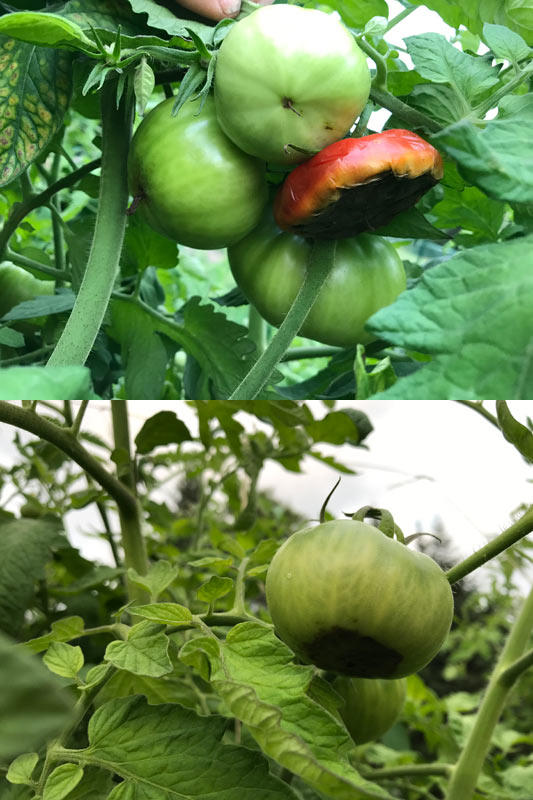Tomato Rot On The Bottom ( What Is It? ) “Blossom End Rot”


(A picture of my tomatoes with rotten bottoms (blossom end rot) )
A surprising number of my tomatoes this year had developed what looks like tomato rot on the bottom. I’ve never seen this before.
What happens is the bottom part of the tomato starts to appear sunken and dark. It literally looks like it’s rotting. The dark spot gets larger, up to 1/3 or even 1/2 the diameter of the tomato. It happens on green tomatoes and red tomatoes.
I estimate that 1/3 of all my tomatoes had this condition!
Have any of you seen this before?
UPDATE: I found this product to help stop blossom end rot:
Blossom Rot Spray
Although I ultimately ended up with a decent harvest from just 8 prolific plants – including the green tomatoes due to a killing frost (five 5-gallon buckets – about 125 pounds), it was unfortunate to throw so many away due to this condition.
Here’s another picture of ‘blossom end rot’

Carrots Love Tomatoes:
Secrets of Companion Planting for Successful Gardening
What is it?
After searching the internet for this ‘rotten tomato’ condition, I discovered that it’s called Blossom End Rot.
At first I thought it was some kind of plant disease. No, it’s not a disease.
It’s a calcium deficiency.
“A tomato’s cells need calcium to grow. Calcium acts like glue in cells – it binds them together.”
Why did it happen?
My next question was, WHY?
My first thought was soil. No, they say it probably is NOT the soil. Most soil has plenty of calcium.
The problem is with the ability of the tomato plant to uptake that calcium. Here’s the best explanation that I found:
Tomatoes absorb calcium through water. But calcium isn’t fast-moving.
If a tomato grows quickly, or if other conditions slow water absorption, then calcium doesn’t have enough time to travel through the whole piece of fruit.
Evidently there are a number of conditions that can slow or inhibit that process.
– Tomato plant grows too quickly
– Cold temperatures
– Cold soil
– Inconsistent watering
– Excessive heat
– Root damage
– Too much nitrogen in soil
The Week-by-Week Vegetable Gardener’s Handbook:
Make the Most of Your Growing Season
Why did my tomato plants get blossom end rot?
I suspect it might have to do with a few things. But I’m not sure.
– I live in the north. It’s cold up here more than it’s hot. Early in the season the soil was on the cold side (although the tomato plants were in a raised garden bed which helps warm during the day – but also cools quicker with any lack of sunshine).
– Mid summer we had periods of excessive heat (very unusual for us) with several official ‘heat waves’.
– The tomato plants grew prolifically. These plants had thick stalks and branches. Very stout and they grew like crazy. perhaps too fast?
Cosmonaut Volkov Tomato
I just wanted to mention that the variety I chose this year was one of the best tasting tomato I’ve tried. I chose these due to their ability to grow well in cold climates and fairly short time to harvest (we have a short growing season up here).
We’re making sauce with our harvest (canning). I wish there was a way to have fresh home grown tomatoes year round!!
Tomato Knife by Wusthof (Top of the line)
More: Ways To Tie Up Tomato Plants
More: 5 Methods of Home Food Preservation
